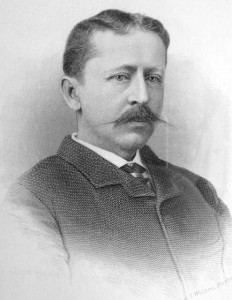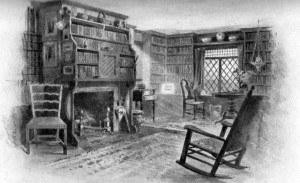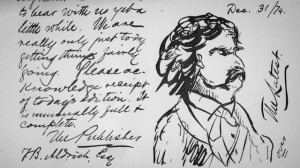True Tales from Canton’s Past: Poet of Ponkapog
By George T. ComeauAt 38 years old, the author had amassed a small fortune and was in a position to purchase the country estate in Ponkapoag. After laboring for 20 years in the editorial mill and publishing seven volumes of poetry and four bestselling books, he had established himself as “one of the most delightful writers of his generation.” Canton became the home of Thomas Bailey Aldrich.
It was a large, sprawling house bordered by his neighbor and closest friend, the mayor of Boston, Henry Pierce, who too lived in Canton. The idyllic setting was punctuated by the sounds of laughter and chaos of Charles and Talbot, Aldrich’s twin boys. The fields and streams became a backyard of wonder for the family and their life at the Sabine Farm. The name of the property was a reference to the country residence of the Roman poet Horace, who would flee to his own Sabine Farm when he needed relief from maddening Rome. In Aldrich’s case, it was a maddening Boston that he escaped.
Thomas Bailey Aldrich was born in 1836 in the seaport town of Portsmouth, New Hampshire. The Aldrich family lived in a variety of places and eventually settled in New Orleans, where his father invested his meager resources in a commission business. Life for the young poet was described as living “in the old Creole city, with its strange, tropical beauty, its exotic sounds and scents,” from which he drew rich and imaginative stories. Within a few years, the family arranged to send Aldrich back north to prepare for his studies and hopefully find the means to send him to Harvard University. Given the poor resources of the family, studying at Cambridge with Professor Longfellow was merely a dream. Instead, Aldrich accepted a clerkship in the counting room of his uncle in New York.
While life in the counting room was particularly dull, Aldrich seemed to have been spending more and more time writing. His uncle humorously observed that the young man “would always be found studying Spanish or doing something equally remote from the commission of business.” Aldrich’s real passion was spent on the third floor of his residence at Clinton Place, where amid his library he “saw such sights, as youthful poets dream — On summer eves by haunted stream.”
In his early literary years, Aldrich published his poems under various pseudonyms. The work was described as “a rich poetical and literary banquet,” and the editor of Atlas Magazine observed that he had “never come across a poet who possessed a more original, chaste, or active imagination.” The early critics applauded his work and at age 19 the young poet was rocketed to stardom and he became almost at once a national celebrity. In time and still in his youth, he became the editor of a major publication, which would further support his literary career.
While a product of New England, his writing was anything but. Aldrich was part of the lively literary scene that was New York City at that time; his companions included Edwin Booth (brother of John Wilkes Booth), the sculptor Launt Thompson, and Walt Whitman. Bohemian New York City did not entirely match Aldrich’s New England temperament, and he spent time between Portsmouth and Boston regularly.
When the Civil War broke out Aldrich became a war correspondent for the New York Tribune attached to General Blenker’s division of the Army of the Potomac in Virginia. One of the first “embedded” journalists, his horrific battlefield experiences would have a heavy influence on his later writings. In 1862 he left Virginia and returned to Portsmouth. Over the next several years he wrote and published poetry and short stories, served as managing editor of the Illustrated News, and divided his time between New York, Boston, and Portsmouth. In 1865 Aldrich married Lillian Woodman — whom he had met through the Booths — and the couple moved to Boston. This suited Aldrich, who said, “Though I am not genuine Boston, I am Boston-plated.”
Not all of Aldrich’s friends saw what he saw in Lillian. Most notably, Mark Twain strongly disliked her, writing in 1893: “Lord, I loathe that woman so! She is an idiot — an absolute idiot — and does not know it … and her husband, the sincerest man that walks … tied for life to this vacant hellion, this clothes-rack, this twaddling, blethering, driveling blatherskite!” Twain certainly got an up-close look at Lillian when he visited Aldrich in Ponkapoag.
From 1881 to 1890, Aldrich was editor of the Atlantic Monthly. As editor, he was embroiled in tension with his publisher, Henry Houghton (co-founder of Houghton Mifflin and the mayor of Cambridge), after refusing to publish commissioned articles by Houghton’s friends, including Woodrow Wilson and Marion Crawford, the governess of England’s royal family. When Houghton chastised Aldrich for turning down submissions from his friends, Aldrich threatened to resign and finally did so in June 1890.
It is, however, Aldrich’s time in Ponkapoag that created a warm and inviting environment for family and friends. It was a summer retreat, and the breezes lifting from the Blue Hill down through the Neponset Valley helped influence some remarkable American literature. There is a beautiful story written by Aldrich in which he describes a small cottage being built on Old Bay Road: “The modest structure was set well back from the road, among the trees, as if the inmates were to care nothing whatever for a view of the stylish equipages which sweep by for the summer season.”
The short story entitled Our New Neighbors at Ponkapog is set at the start of the spring season, and in it Aldrich describes our village beautifully. It bears reprint for the visuals that spring forth from his pen:
“For after its black bass and wild duck and teal, solitude is the chief staple of Ponkapog. Perhaps its perfect rural loveliness should be included. Lying high up under the wing of the Blue Hills, and in the odorous breath of pines and cedars, it chances to be the most enchanting bit of unlaced disheveled country within fifty miles of Boston, which, moreover, can be reached in half an hour’s ride by railway. But the nearest railway station (Heaven be praised!) is two miles distant, and the seclusion is without a flaw. Ponkapog has one mail a day; two mails a day would render the place uninhabitable.
“The village — it looks like a compact village at a distance, but unravels and disappears the moment you drive into it — has quite a large floating population. I do not allude to the perch and pickerel in Ponk-apog Pond. Along the Old Bay Road, a highway even in the colonial days, there are a number of attractive villas and cottages straggling off towards Milton, which are occupied for the summer by people from the city.”
The short story continues and has a wonderful twist at the end. But suffice to say, the “new neighbors” do not turn out to be what they seem.
Eventually, the summer home evolved and Aldrich spent more of his time here in the countryside. More than one half of his collected prose was written here. Winters were punctuated with European tours and a return to spend time with his twins in Canton. Corresponding with friends took a great deal of his time. The Houghton Library at Harvard holds a large collection of papers owned by Aldrich, and more than 80 letters were written from Ponkapoag.
Perhaps the finest exchange of mail ever written connected to Canton and Aldrich occurred in December 1874. Aldrich desired to embellish his library with a picture of Mark Twain, and after receiving the request, Mr. Clemens obligingly began sending him one a day. “After two weeks Aldrich mildly protested against the photographic deluge, with the result that on New Year’s Day, 1875, he received 20 separate copies of the effigies.” What ensued was a series of exchanges between Clemens and Aldrich.
In a letter mockingly written from “Police Headquarters, Ponkapog, Mass. January 1, 1875,” Aldrich writes, “Sir, – At 4 p.m. this day, the entire Constabulary force of Ponkapog – consisting of two men and a resolute boy – broke camp on the border of Wampumsoagg Pond, and took up its march in four columns to the scene of action – the post-office. There they formed in a hollow square, and moved upon the postmaster. The mail had already arrived, but the post agent refused to deliver it to the force. The truculent official was twice run through the mince-meat machine before he would disclose the place where he had secreted the mail bag. The bag, as was suspected, contained additional evidence of the dreadful persecution that is going on in our midst. There were found no fewer than 20 of those seditious, iniquitous, diabolical, and highly objectionable prints, engravings, and photographs, which have lately been showered upon – perhaps hurled would be a better word – upon Mr. Thomas Bailey Aldrich, a respectable and inoffensive citizen of Ponkapog.”
Perhaps the best part of the joke was written on the outside of the envelope: “It is no use for that person to send any more letters here. The post office at this point is to be blown up. Forty-eight hogsheads of nitro-glycerine have been surreptitiously introduced into the building … the greatest excitement combined with the most intense quietness reigns at Ponkapog.” This was one of America’s greatest writers at his best — and right here Canton.
Short URL: https://www.thecantoncitizen.com/?p=26499













